MKT3SEM Social Marketing Plan: Cyberbullying in Primary Schools
VerifiedAdded on 2022/12/14
|10
|2336
|356
Report
AI Summary
This report presents a comprehensive social marketing plan aimed at mitigating cyberbullying within Australian primary schools. The plan begins with an analysis of supporting literature, highlighting the prevalence and impact of cyberbullying, followed by a clear definition of the social marketing problem. It then delves into situation analysis, identifying key stakeholders like students, parents, schools, and social media platforms, and discusses relevant upstream policy issues. The report outlines the application of social cognitive theory to inform the intervention strategies and details segmentation and targeting approaches, focusing on the primary school age group and utilizing social media. The marketing mix (4Ps) is addressed, including product (a reporting application), price (anonymity), place (online platforms), and promotion (social media campaigns). The plan also emphasizes people and partnerships, fostering collaboration among stakeholders. Finally, the report discusses implementation strategies, emphasizing the need for school-based initiatives and evaluation methods to assess the plan's effectiveness in reducing cyberbullying and promoting positive online behavior among students. References to relevant articles are included.
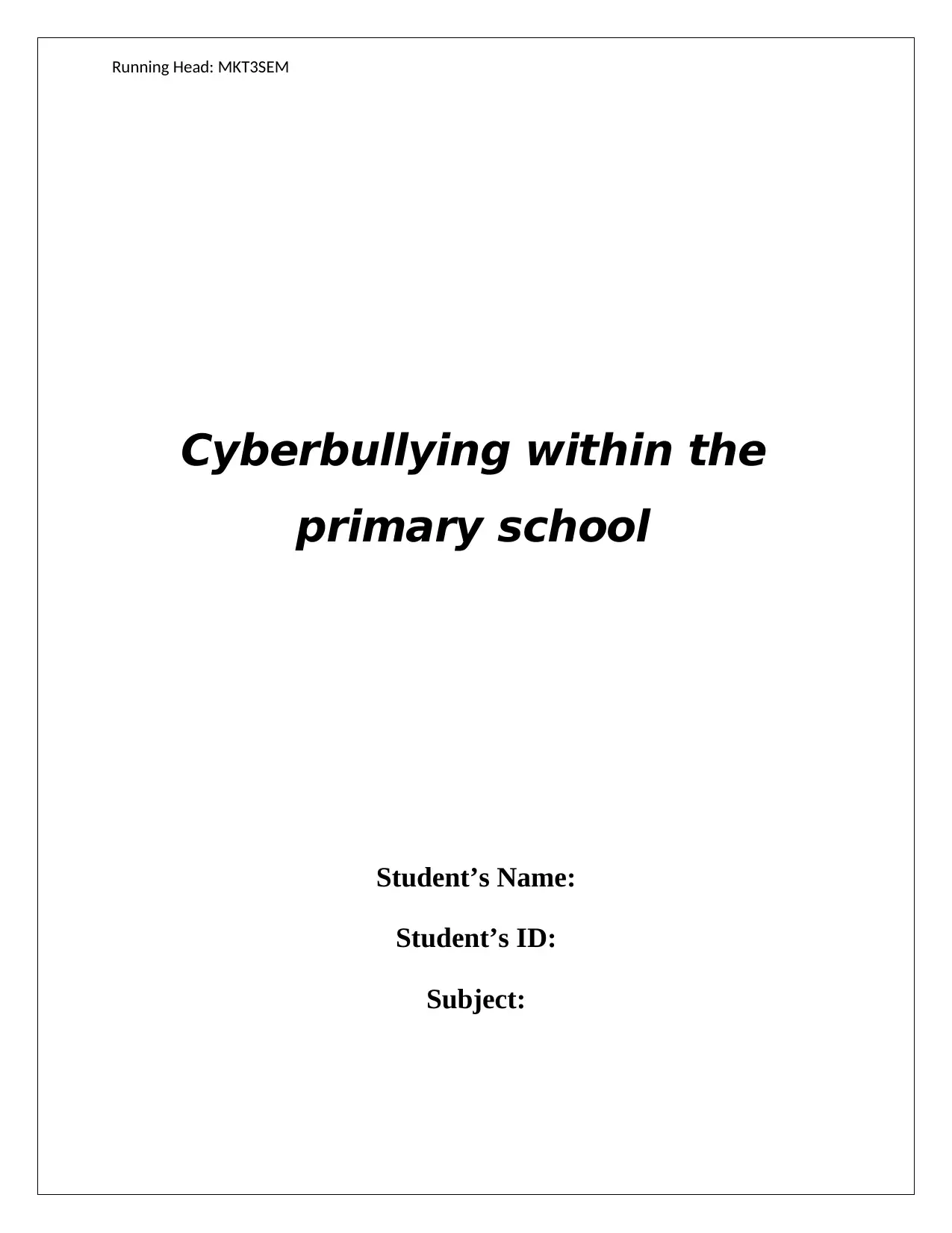
Running Head: MKT3SEM
Cyberbullying within the
primary school
Student’s Name:
Student’s ID:
Subject:
Cyberbullying within the
primary school
Student’s Name:
Student’s ID:
Subject:
Paraphrase This Document
Need a fresh take? Get an instant paraphrase of this document with our AI Paraphraser
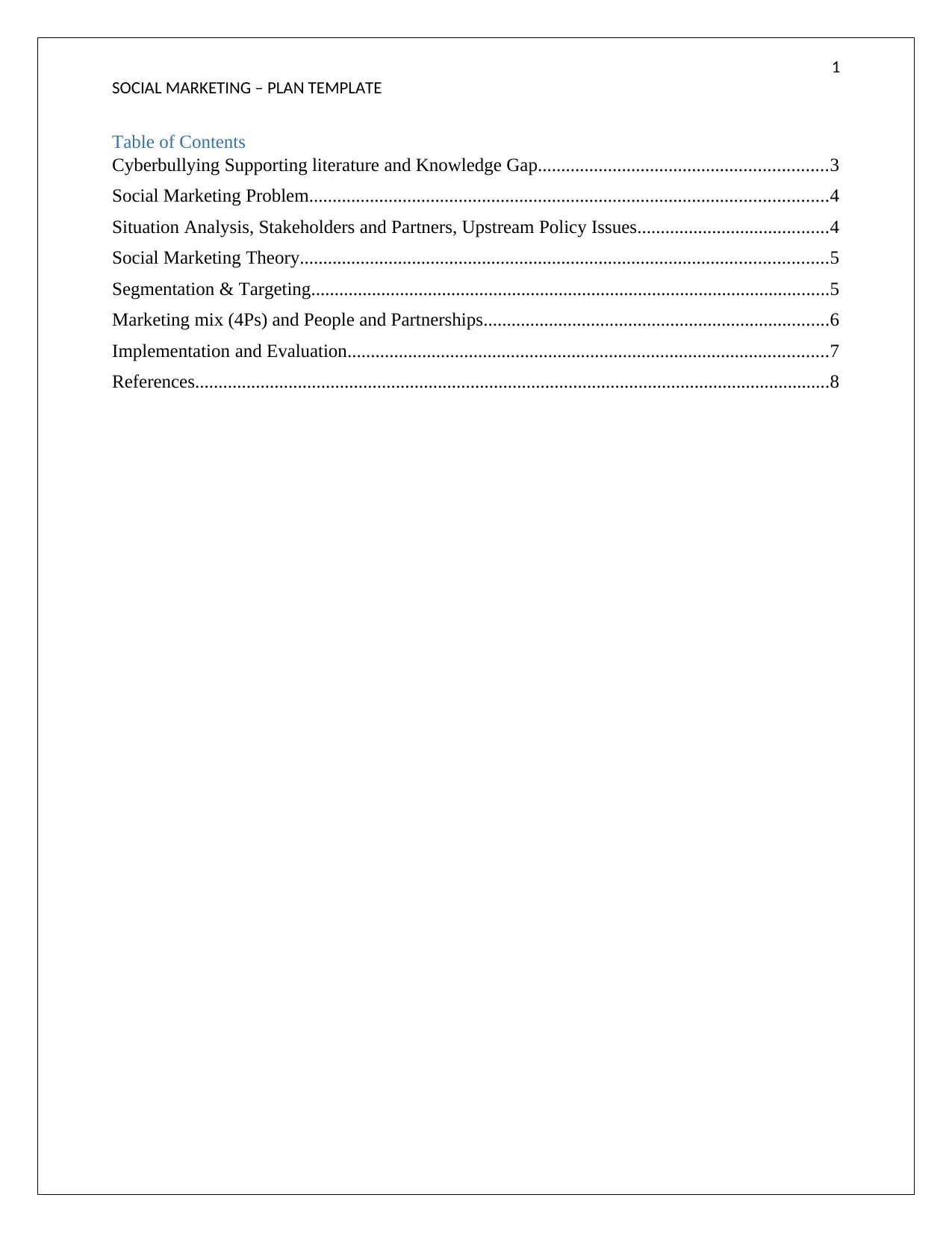
1
SOCIAL MARKETING – PLAN TEMPLATE
Table of Contents
Cyberbullying Supporting literature and Knowledge Gap..............................................................3
Social Marketing Problem...............................................................................................................4
Situation Analysis, Stakeholders and Partners, Upstream Policy Issues.........................................4
Social Marketing Theory.................................................................................................................5
Segmentation & Targeting...............................................................................................................5
Marketing mix (4Ps) and People and Partnerships..........................................................................6
Implementation and Evaluation.......................................................................................................7
References........................................................................................................................................8
SOCIAL MARKETING – PLAN TEMPLATE
Table of Contents
Cyberbullying Supporting literature and Knowledge Gap..............................................................3
Social Marketing Problem...............................................................................................................4
Situation Analysis, Stakeholders and Partners, Upstream Policy Issues.........................................4
Social Marketing Theory.................................................................................................................5
Segmentation & Targeting...............................................................................................................5
Marketing mix (4Ps) and People and Partnerships..........................................................................6
Implementation and Evaluation.......................................................................................................7
References........................................................................................................................................8
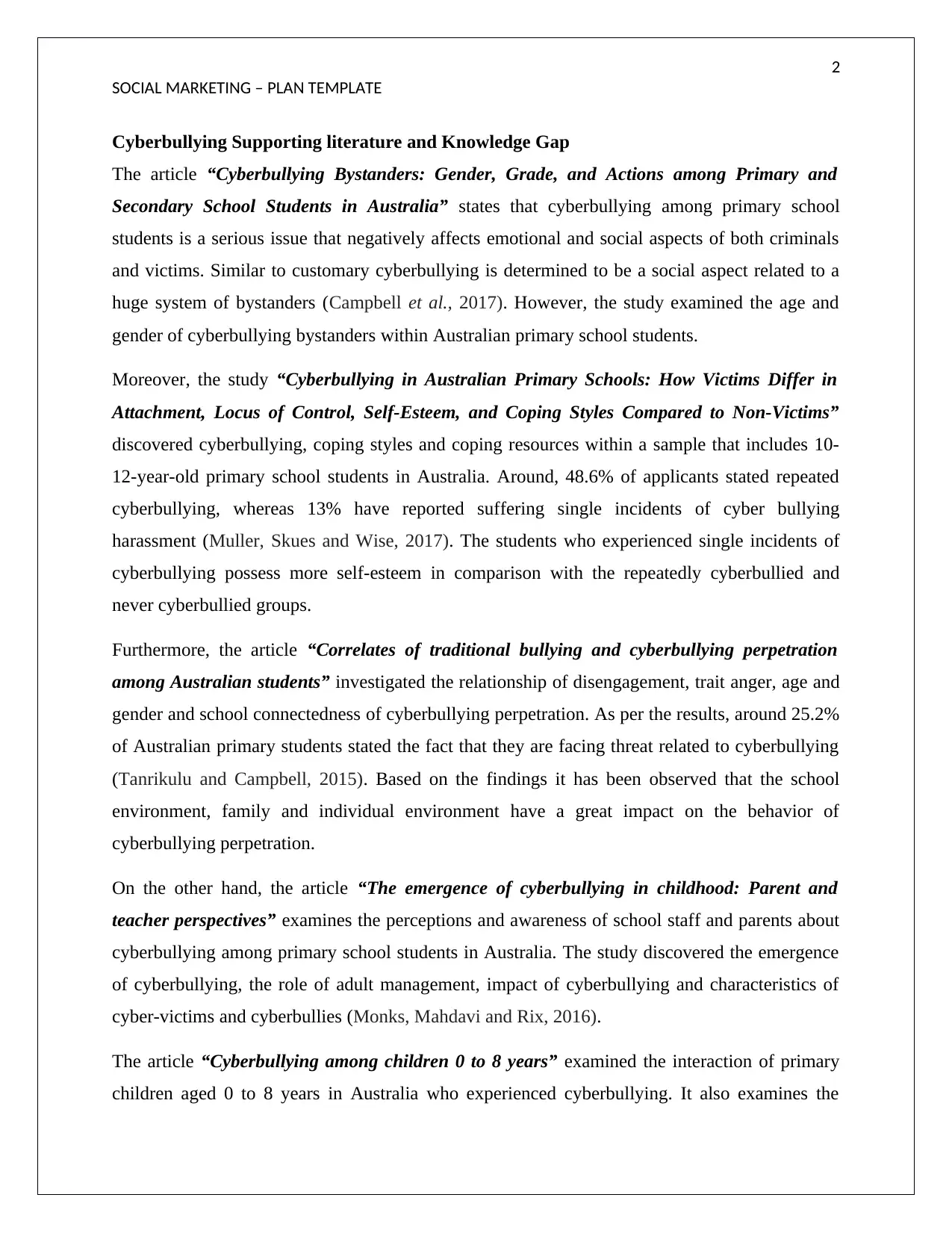
2
SOCIAL MARKETING – PLAN TEMPLATE
Cyberbullying Supporting literature and Knowledge Gap
The article “Cyberbullying Bystanders: Gender, Grade, and Actions among Primary and
Secondary School Students in Australia” states that cyberbullying among primary school
students is a serious issue that negatively affects emotional and social aspects of both criminals
and victims. Similar to customary cyberbullying is determined to be a social aspect related to a
huge system of bystanders (Campbell et al., 2017). However, the study examined the age and
gender of cyberbullying bystanders within Australian primary school students.
Moreover, the study “Cyberbullying in Australian Primary Schools: How Victims Differ in
Attachment, Locus of Control, Self-Esteem, and Coping Styles Compared to Non-Victims”
discovered cyberbullying, coping styles and coping resources within a sample that includes 10-
12-year-old primary school students in Australia. Around, 48.6% of applicants stated repeated
cyberbullying, whereas 13% have reported suffering single incidents of cyber bullying
harassment (Muller, Skues and Wise, 2017). The students who experienced single incidents of
cyberbullying possess more self-esteem in comparison with the repeatedly cyberbullied and
never cyberbullied groups.
Furthermore, the article “Correlates of traditional bullying and cyberbullying perpetration
among Australian students” investigated the relationship of disengagement, trait anger, age and
gender and school connectedness of cyberbullying perpetration. As per the results, around 25.2%
of Australian primary students stated the fact that they are facing threat related to cyberbullying
(Tanrikulu and Campbell, 2015). Based on the findings it has been observed that the school
environment, family and individual environment have a great impact on the behavior of
cyberbullying perpetration.
On the other hand, the article “The emergence of cyberbullying in childhood: Parent and
teacher perspectives” examines the perceptions and awareness of school staff and parents about
cyberbullying among primary school students in Australia. The study discovered the emergence
of cyberbullying, the role of adult management, impact of cyberbullying and characteristics of
cyber-victims and cyberbullies (Monks, Mahdavi and Rix, 2016).
The article “Cyberbullying among children 0 to 8 years” examined the interaction of primary
children aged 0 to 8 years in Australia who experienced cyberbullying. It also examines the
SOCIAL MARKETING – PLAN TEMPLATE
Cyberbullying Supporting literature and Knowledge Gap
The article “Cyberbullying Bystanders: Gender, Grade, and Actions among Primary and
Secondary School Students in Australia” states that cyberbullying among primary school
students is a serious issue that negatively affects emotional and social aspects of both criminals
and victims. Similar to customary cyberbullying is determined to be a social aspect related to a
huge system of bystanders (Campbell et al., 2017). However, the study examined the age and
gender of cyberbullying bystanders within Australian primary school students.
Moreover, the study “Cyberbullying in Australian Primary Schools: How Victims Differ in
Attachment, Locus of Control, Self-Esteem, and Coping Styles Compared to Non-Victims”
discovered cyberbullying, coping styles and coping resources within a sample that includes 10-
12-year-old primary school students in Australia. Around, 48.6% of applicants stated repeated
cyberbullying, whereas 13% have reported suffering single incidents of cyber bullying
harassment (Muller, Skues and Wise, 2017). The students who experienced single incidents of
cyberbullying possess more self-esteem in comparison with the repeatedly cyberbullied and
never cyberbullied groups.
Furthermore, the article “Correlates of traditional bullying and cyberbullying perpetration
among Australian students” investigated the relationship of disengagement, trait anger, age and
gender and school connectedness of cyberbullying perpetration. As per the results, around 25.2%
of Australian primary students stated the fact that they are facing threat related to cyberbullying
(Tanrikulu and Campbell, 2015). Based on the findings it has been observed that the school
environment, family and individual environment have a great impact on the behavior of
cyberbullying perpetration.
On the other hand, the article “The emergence of cyberbullying in childhood: Parent and
teacher perspectives” examines the perceptions and awareness of school staff and parents about
cyberbullying among primary school students in Australia. The study discovered the emergence
of cyberbullying, the role of adult management, impact of cyberbullying and characteristics of
cyber-victims and cyberbullies (Monks, Mahdavi and Rix, 2016).
The article “Cyberbullying among children 0 to 8 years” examined the interaction of primary
children aged 0 to 8 years in Australia who experienced cyberbullying. It also examines the
⊘ This is a preview!⊘
Do you want full access?
Subscribe today to unlock all pages.

Trusted by 1+ million students worldwide
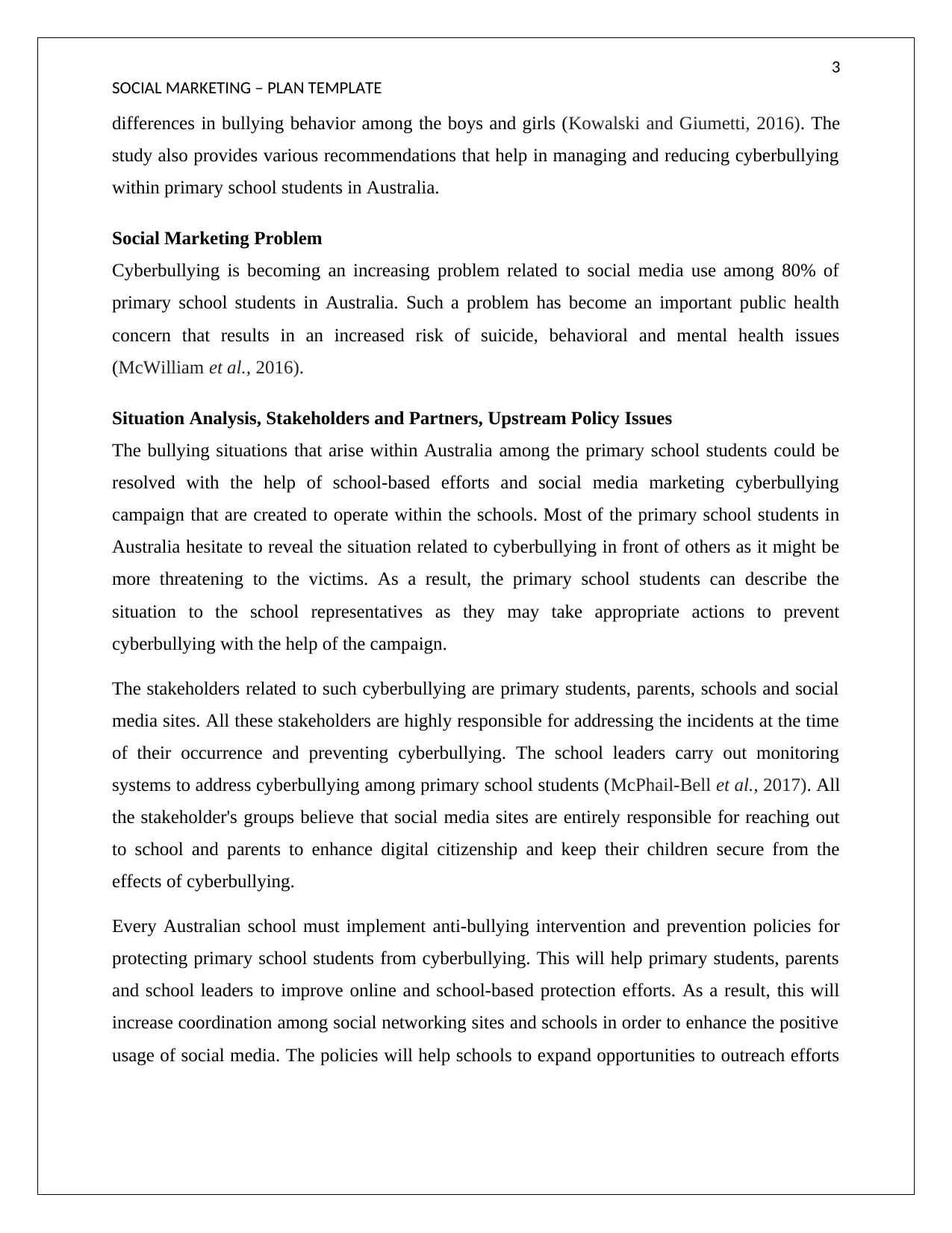
3
SOCIAL MARKETING – PLAN TEMPLATE
differences in bullying behavior among the boys and girls (Kowalski and Giumetti, 2016). The
study also provides various recommendations that help in managing and reducing cyberbullying
within primary school students in Australia.
Social Marketing Problem
Cyberbullying is becoming an increasing problem related to social media use among 80% of
primary school students in Australia. Such a problem has become an important public health
concern that results in an increased risk of suicide, behavioral and mental health issues
(McWilliam et al., 2016).
Situation Analysis, Stakeholders and Partners, Upstream Policy Issues
The bullying situations that arise within Australia among the primary school students could be
resolved with the help of school-based efforts and social media marketing cyberbullying
campaign that are created to operate within the schools. Most of the primary school students in
Australia hesitate to reveal the situation related to cyberbullying in front of others as it might be
more threatening to the victims. As a result, the primary school students can describe the
situation to the school representatives as they may take appropriate actions to prevent
cyberbullying with the help of the campaign.
The stakeholders related to such cyberbullying are primary students, parents, schools and social
media sites. All these stakeholders are highly responsible for addressing the incidents at the time
of their occurrence and preventing cyberbullying. The school leaders carry out monitoring
systems to address cyberbullying among primary school students (McPhail-Bell et al., 2017). All
the stakeholder's groups believe that social media sites are entirely responsible for reaching out
to school and parents to enhance digital citizenship and keep their children secure from the
effects of cyberbullying.
Every Australian school must implement anti-bullying intervention and prevention policies for
protecting primary school students from cyberbullying. This will help primary students, parents
and school leaders to improve online and school-based protection efforts. As a result, this will
increase coordination among social networking sites and schools in order to enhance the positive
usage of social media. The policies will help schools to expand opportunities to outreach efforts
SOCIAL MARKETING – PLAN TEMPLATE
differences in bullying behavior among the boys and girls (Kowalski and Giumetti, 2016). The
study also provides various recommendations that help in managing and reducing cyberbullying
within primary school students in Australia.
Social Marketing Problem
Cyberbullying is becoming an increasing problem related to social media use among 80% of
primary school students in Australia. Such a problem has become an important public health
concern that results in an increased risk of suicide, behavioral and mental health issues
(McWilliam et al., 2016).
Situation Analysis, Stakeholders and Partners, Upstream Policy Issues
The bullying situations that arise within Australia among the primary school students could be
resolved with the help of school-based efforts and social media marketing cyberbullying
campaign that are created to operate within the schools. Most of the primary school students in
Australia hesitate to reveal the situation related to cyberbullying in front of others as it might be
more threatening to the victims. As a result, the primary school students can describe the
situation to the school representatives as they may take appropriate actions to prevent
cyberbullying with the help of the campaign.
The stakeholders related to such cyberbullying are primary students, parents, schools and social
media sites. All these stakeholders are highly responsible for addressing the incidents at the time
of their occurrence and preventing cyberbullying. The school leaders carry out monitoring
systems to address cyberbullying among primary school students (McPhail-Bell et al., 2017). All
the stakeholder's groups believe that social media sites are entirely responsible for reaching out
to school and parents to enhance digital citizenship and keep their children secure from the
effects of cyberbullying.
Every Australian school must implement anti-bullying intervention and prevention policies for
protecting primary school students from cyberbullying. This will help primary students, parents
and school leaders to improve online and school-based protection efforts. As a result, this will
increase coordination among social networking sites and schools in order to enhance the positive
usage of social media. The policies will help schools to expand opportunities to outreach efforts
Paraphrase This Document
Need a fresh take? Get an instant paraphrase of this document with our AI Paraphraser
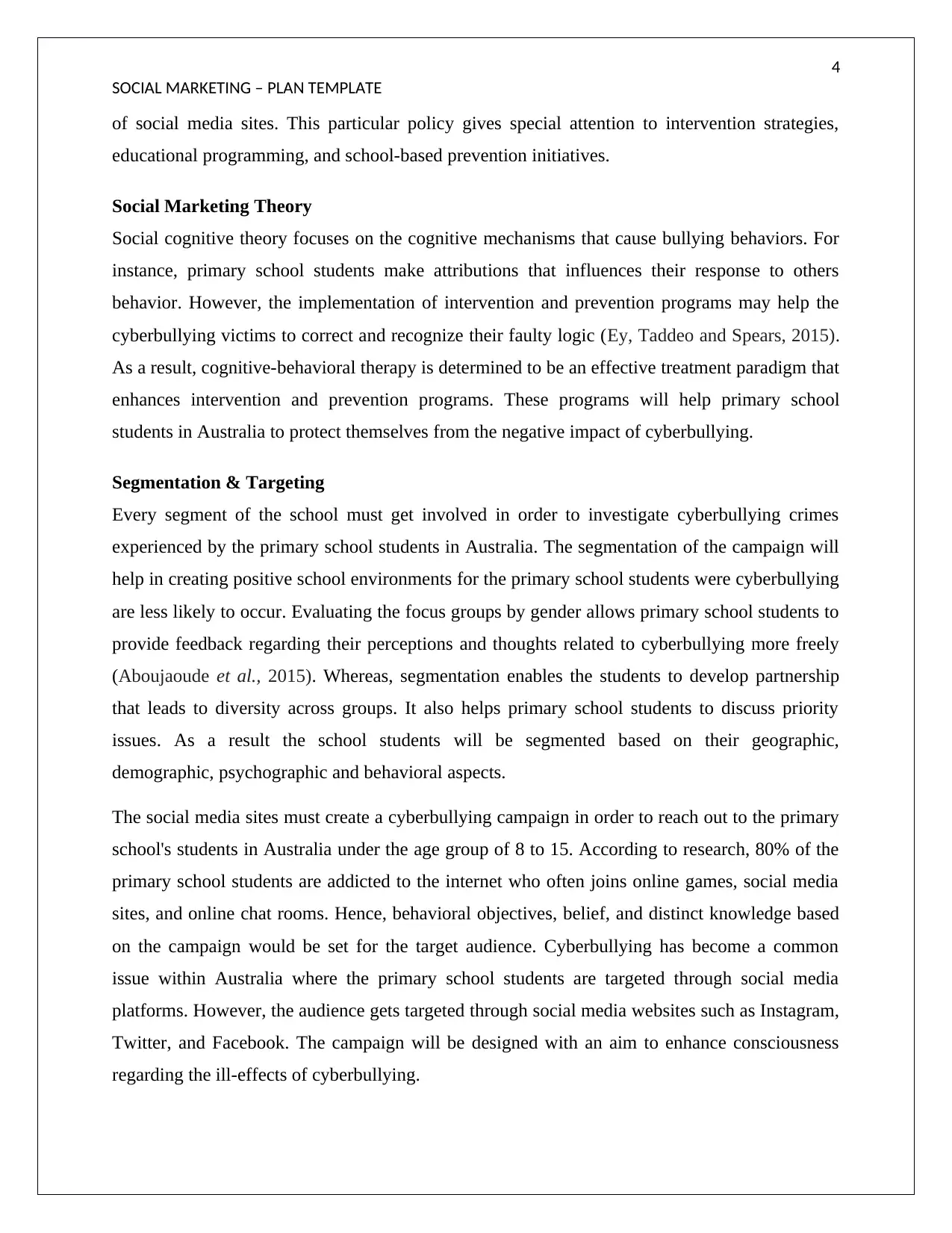
4
SOCIAL MARKETING – PLAN TEMPLATE
of social media sites. This particular policy gives special attention to intervention strategies,
educational programming, and school-based prevention initiatives.
Social Marketing Theory
Social cognitive theory focuses on the cognitive mechanisms that cause bullying behaviors. For
instance, primary school students make attributions that influences their response to others
behavior. However, the implementation of intervention and prevention programs may help the
cyberbullying victims to correct and recognize their faulty logic (Ey, Taddeo and Spears, 2015).
As a result, cognitive-behavioral therapy is determined to be an effective treatment paradigm that
enhances intervention and prevention programs. These programs will help primary school
students in Australia to protect themselves from the negative impact of cyberbullying.
Segmentation & Targeting
Every segment of the school must get involved in order to investigate cyberbullying crimes
experienced by the primary school students in Australia. The segmentation of the campaign will
help in creating positive school environments for the primary school students were cyberbullying
are less likely to occur. Evaluating the focus groups by gender allows primary school students to
provide feedback regarding their perceptions and thoughts related to cyberbullying more freely
(Aboujaoude et al., 2015). Whereas, segmentation enables the students to develop partnership
that leads to diversity across groups. It also helps primary school students to discuss priority
issues. As a result the school students will be segmented based on their geographic,
demographic, psychographic and behavioral aspects.
The social media sites must create a cyberbullying campaign in order to reach out to the primary
school's students in Australia under the age group of 8 to 15. According to research, 80% of the
primary school students are addicted to the internet who often joins online games, social media
sites, and online chat rooms. Hence, behavioral objectives, belief, and distinct knowledge based
on the campaign would be set for the target audience. Cyberbullying has become a common
issue within Australia where the primary school students are targeted through social media
platforms. However, the audience gets targeted through social media websites such as Instagram,
Twitter, and Facebook. The campaign will be designed with an aim to enhance consciousness
regarding the ill-effects of cyberbullying.
SOCIAL MARKETING – PLAN TEMPLATE
of social media sites. This particular policy gives special attention to intervention strategies,
educational programming, and school-based prevention initiatives.
Social Marketing Theory
Social cognitive theory focuses on the cognitive mechanisms that cause bullying behaviors. For
instance, primary school students make attributions that influences their response to others
behavior. However, the implementation of intervention and prevention programs may help the
cyberbullying victims to correct and recognize their faulty logic (Ey, Taddeo and Spears, 2015).
As a result, cognitive-behavioral therapy is determined to be an effective treatment paradigm that
enhances intervention and prevention programs. These programs will help primary school
students in Australia to protect themselves from the negative impact of cyberbullying.
Segmentation & Targeting
Every segment of the school must get involved in order to investigate cyberbullying crimes
experienced by the primary school students in Australia. The segmentation of the campaign will
help in creating positive school environments for the primary school students were cyberbullying
are less likely to occur. Evaluating the focus groups by gender allows primary school students to
provide feedback regarding their perceptions and thoughts related to cyberbullying more freely
(Aboujaoude et al., 2015). Whereas, segmentation enables the students to develop partnership
that leads to diversity across groups. It also helps primary school students to discuss priority
issues. As a result the school students will be segmented based on their geographic,
demographic, psychographic and behavioral aspects.
The social media sites must create a cyberbullying campaign in order to reach out to the primary
school's students in Australia under the age group of 8 to 15. According to research, 80% of the
primary school students are addicted to the internet who often joins online games, social media
sites, and online chat rooms. Hence, behavioral objectives, belief, and distinct knowledge based
on the campaign would be set for the target audience. Cyberbullying has become a common
issue within Australia where the primary school students are targeted through social media
platforms. However, the audience gets targeted through social media websites such as Instagram,
Twitter, and Facebook. The campaign will be designed with an aim to enhance consciousness
regarding the ill-effects of cyberbullying.
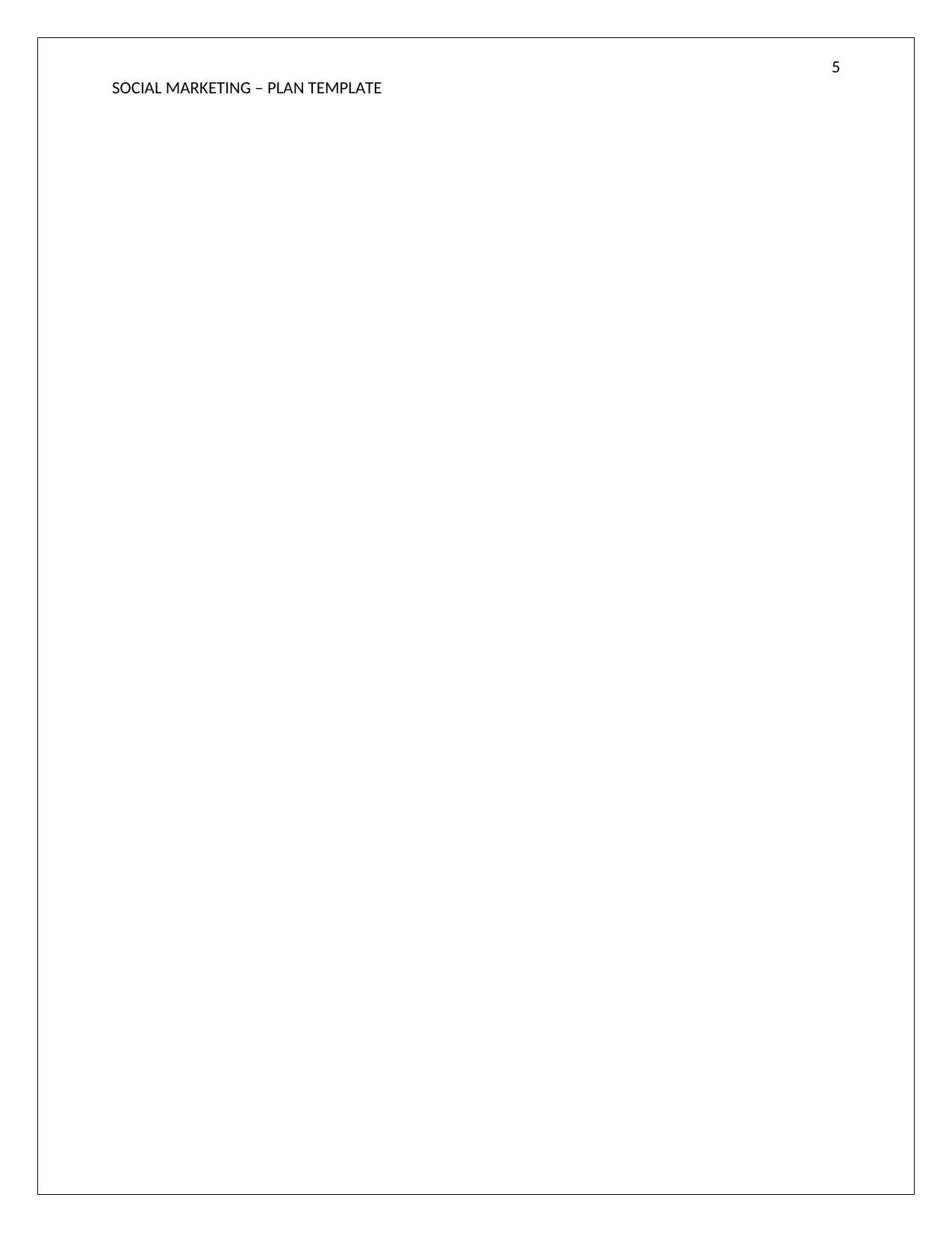
5
SOCIAL MARKETING – PLAN TEMPLATE
SOCIAL MARKETING – PLAN TEMPLATE
⊘ This is a preview!⊘
Do you want full access?
Subscribe today to unlock all pages.

Trusted by 1+ million students worldwide
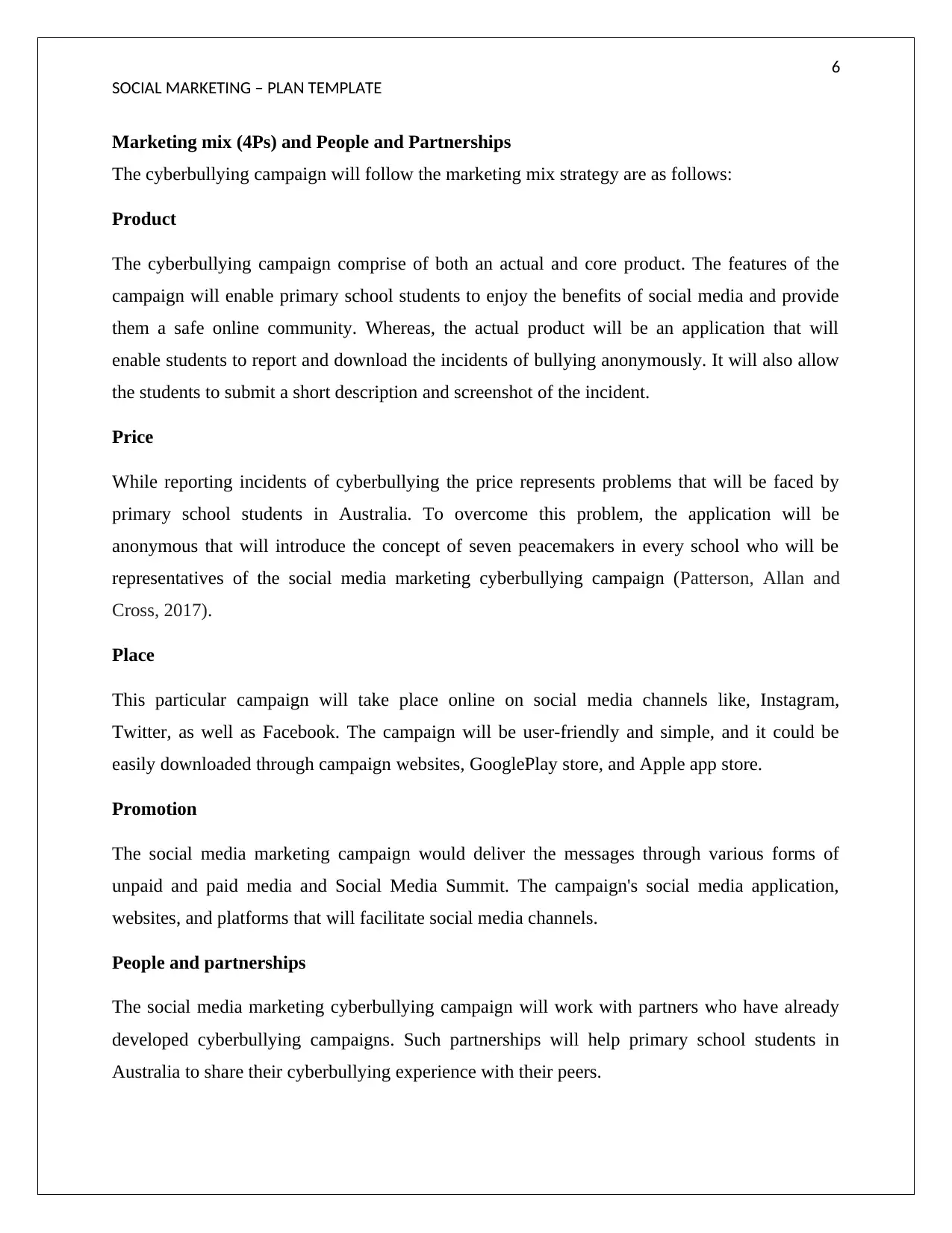
6
SOCIAL MARKETING – PLAN TEMPLATE
Marketing mix (4Ps) and People and Partnerships
The cyberbullying campaign will follow the marketing mix strategy are as follows:
Product
The cyberbullying campaign comprise of both an actual and core product. The features of the
campaign will enable primary school students to enjoy the benefits of social media and provide
them a safe online community. Whereas, the actual product will be an application that will
enable students to report and download the incidents of bullying anonymously. It will also allow
the students to submit a short description and screenshot of the incident.
Price
While reporting incidents of cyberbullying the price represents problems that will be faced by
primary school students in Australia. To overcome this problem, the application will be
anonymous that will introduce the concept of seven peacemakers in every school who will be
representatives of the social media marketing cyberbullying campaign (Patterson, Allan and
Cross, 2017).
Place
This particular campaign will take place online on social media channels like, Instagram,
Twitter, as well as Facebook. The campaign will be user-friendly and simple, and it could be
easily downloaded through campaign websites, GooglePlay store, and Apple app store.
Promotion
The social media marketing campaign would deliver the messages through various forms of
unpaid and paid media and Social Media Summit. The campaign's social media application,
websites, and platforms that will facilitate social media channels.
People and partnerships
The social media marketing cyberbullying campaign will work with partners who have already
developed cyberbullying campaigns. Such partnerships will help primary school students in
Australia to share their cyberbullying experience with their peers.
SOCIAL MARKETING – PLAN TEMPLATE
Marketing mix (4Ps) and People and Partnerships
The cyberbullying campaign will follow the marketing mix strategy are as follows:
Product
The cyberbullying campaign comprise of both an actual and core product. The features of the
campaign will enable primary school students to enjoy the benefits of social media and provide
them a safe online community. Whereas, the actual product will be an application that will
enable students to report and download the incidents of bullying anonymously. It will also allow
the students to submit a short description and screenshot of the incident.
Price
While reporting incidents of cyberbullying the price represents problems that will be faced by
primary school students in Australia. To overcome this problem, the application will be
anonymous that will introduce the concept of seven peacemakers in every school who will be
representatives of the social media marketing cyberbullying campaign (Patterson, Allan and
Cross, 2017).
Place
This particular campaign will take place online on social media channels like, Instagram,
Twitter, as well as Facebook. The campaign will be user-friendly and simple, and it could be
easily downloaded through campaign websites, GooglePlay store, and Apple app store.
Promotion
The social media marketing campaign would deliver the messages through various forms of
unpaid and paid media and Social Media Summit. The campaign's social media application,
websites, and platforms that will facilitate social media channels.
People and partnerships
The social media marketing cyberbullying campaign will work with partners who have already
developed cyberbullying campaigns. Such partnerships will help primary school students in
Australia to share their cyberbullying experience with their peers.
Paraphrase This Document
Need a fresh take? Get an instant paraphrase of this document with our AI Paraphraser
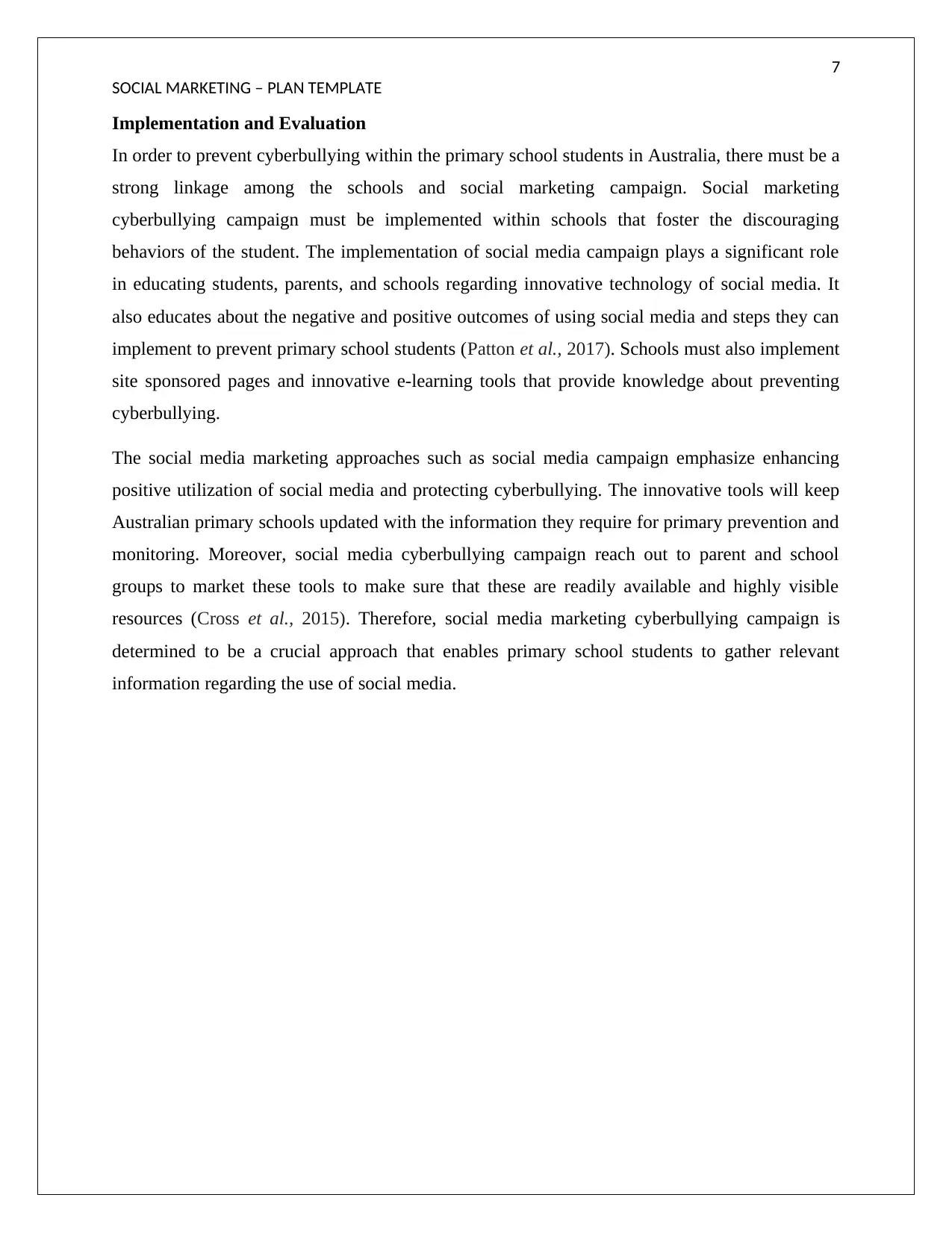
7
SOCIAL MARKETING – PLAN TEMPLATE
Implementation and Evaluation
In order to prevent cyberbullying within the primary school students in Australia, there must be a
strong linkage among the schools and social marketing campaign. Social marketing
cyberbullying campaign must be implemented within schools that foster the discouraging
behaviors of the student. The implementation of social media campaign plays a significant role
in educating students, parents, and schools regarding innovative technology of social media. It
also educates about the negative and positive outcomes of using social media and steps they can
implement to prevent primary school students (Patton et al., 2017). Schools must also implement
site sponsored pages and innovative e-learning tools that provide knowledge about preventing
cyberbullying.
The social media marketing approaches such as social media campaign emphasize enhancing
positive utilization of social media and protecting cyberbullying. The innovative tools will keep
Australian primary schools updated with the information they require for primary prevention and
monitoring. Moreover, social media cyberbullying campaign reach out to parent and school
groups to market these tools to make sure that these are readily available and highly visible
resources (Cross et al., 2015). Therefore, social media marketing cyberbullying campaign is
determined to be a crucial approach that enables primary school students to gather relevant
information regarding the use of social media.
SOCIAL MARKETING – PLAN TEMPLATE
Implementation and Evaluation
In order to prevent cyberbullying within the primary school students in Australia, there must be a
strong linkage among the schools and social marketing campaign. Social marketing
cyberbullying campaign must be implemented within schools that foster the discouraging
behaviors of the student. The implementation of social media campaign plays a significant role
in educating students, parents, and schools regarding innovative technology of social media. It
also educates about the negative and positive outcomes of using social media and steps they can
implement to prevent primary school students (Patton et al., 2017). Schools must also implement
site sponsored pages and innovative e-learning tools that provide knowledge about preventing
cyberbullying.
The social media marketing approaches such as social media campaign emphasize enhancing
positive utilization of social media and protecting cyberbullying. The innovative tools will keep
Australian primary schools updated with the information they require for primary prevention and
monitoring. Moreover, social media cyberbullying campaign reach out to parent and school
groups to market these tools to make sure that these are readily available and highly visible
resources (Cross et al., 2015). Therefore, social media marketing cyberbullying campaign is
determined to be a crucial approach that enables primary school students to gather relevant
information regarding the use of social media.
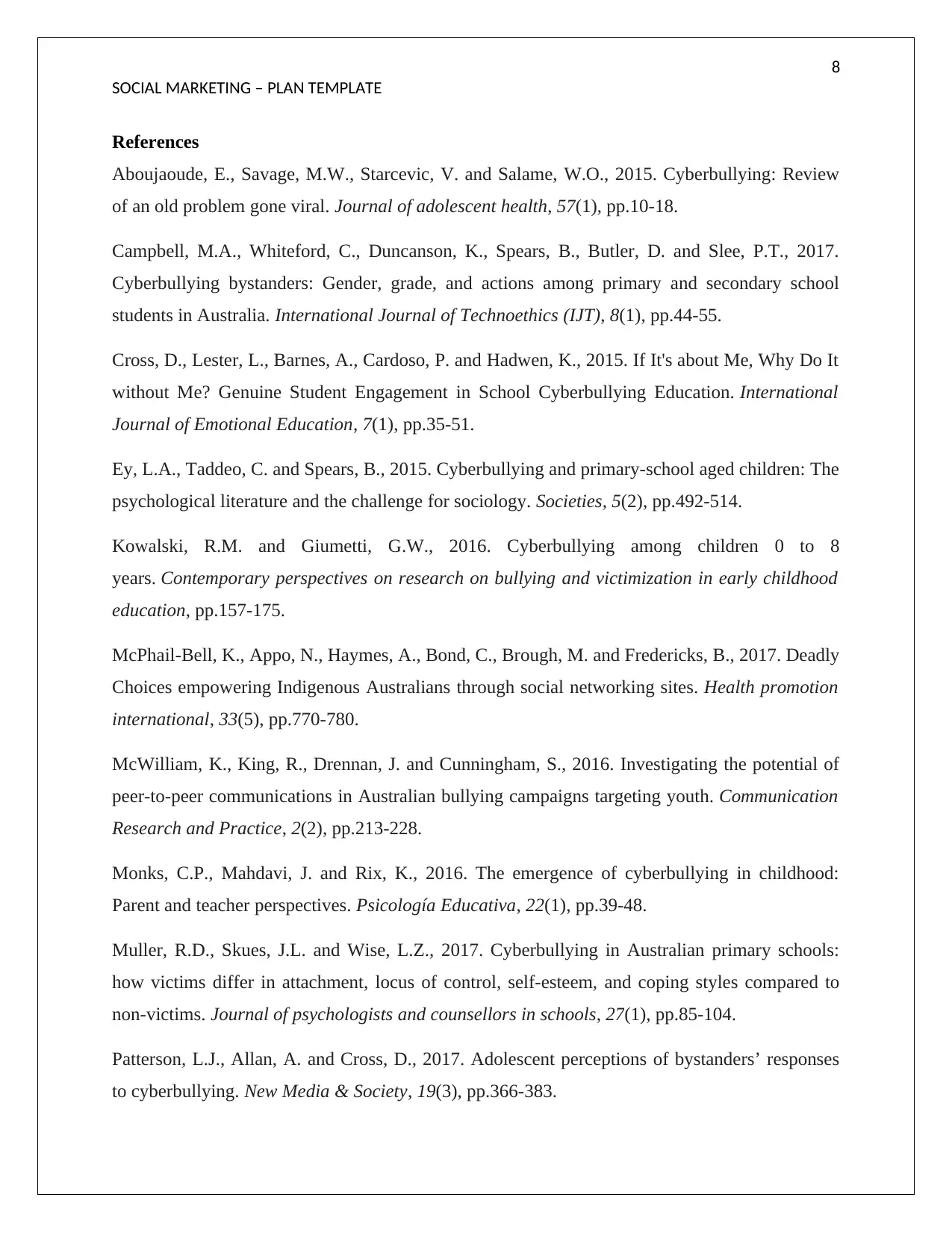
8
SOCIAL MARKETING – PLAN TEMPLATE
References
Aboujaoude, E., Savage, M.W., Starcevic, V. and Salame, W.O., 2015. Cyberbullying: Review
of an old problem gone viral. Journal of adolescent health, 57(1), pp.10-18.
Campbell, M.A., Whiteford, C., Duncanson, K., Spears, B., Butler, D. and Slee, P.T., 2017.
Cyberbullying bystanders: Gender, grade, and actions among primary and secondary school
students in Australia. International Journal of Technoethics (IJT), 8(1), pp.44-55.
Cross, D., Lester, L., Barnes, A., Cardoso, P. and Hadwen, K., 2015. If It's about Me, Why Do It
without Me? Genuine Student Engagement in School Cyberbullying Education. International
Journal of Emotional Education, 7(1), pp.35-51.
Ey, L.A., Taddeo, C. and Spears, B., 2015. Cyberbullying and primary-school aged children: The
psychological literature and the challenge for sociology. Societies, 5(2), pp.492-514.
Kowalski, R.M. and Giumetti, G.W., 2016. Cyberbullying among children 0 to 8
years. Contemporary perspectives on research on bullying and victimization in early childhood
education, pp.157-175.
McPhail-Bell, K., Appo, N., Haymes, A., Bond, C., Brough, M. and Fredericks, B., 2017. Deadly
Choices empowering Indigenous Australians through social networking sites. Health promotion
international, 33(5), pp.770-780.
McWilliam, K., King, R., Drennan, J. and Cunningham, S., 2016. Investigating the potential of
peer-to-peer communications in Australian bullying campaigns targeting youth. Communication
Research and Practice, 2(2), pp.213-228.
Monks, C.P., Mahdavi, J. and Rix, K., 2016. The emergence of cyberbullying in childhood:
Parent and teacher perspectives. Psicología Educativa, 22(1), pp.39-48.
Muller, R.D., Skues, J.L. and Wise, L.Z., 2017. Cyberbullying in Australian primary schools:
how victims differ in attachment, locus of control, self-esteem, and coping styles compared to
non-victims. Journal of psychologists and counsellors in schools, 27(1), pp.85-104.
Patterson, L.J., Allan, A. and Cross, D., 2017. Adolescent perceptions of bystanders’ responses
to cyberbullying. New Media & Society, 19(3), pp.366-383.
SOCIAL MARKETING – PLAN TEMPLATE
References
Aboujaoude, E., Savage, M.W., Starcevic, V. and Salame, W.O., 2015. Cyberbullying: Review
of an old problem gone viral. Journal of adolescent health, 57(1), pp.10-18.
Campbell, M.A., Whiteford, C., Duncanson, K., Spears, B., Butler, D. and Slee, P.T., 2017.
Cyberbullying bystanders: Gender, grade, and actions among primary and secondary school
students in Australia. International Journal of Technoethics (IJT), 8(1), pp.44-55.
Cross, D., Lester, L., Barnes, A., Cardoso, P. and Hadwen, K., 2015. If It's about Me, Why Do It
without Me? Genuine Student Engagement in School Cyberbullying Education. International
Journal of Emotional Education, 7(1), pp.35-51.
Ey, L.A., Taddeo, C. and Spears, B., 2015. Cyberbullying and primary-school aged children: The
psychological literature and the challenge for sociology. Societies, 5(2), pp.492-514.
Kowalski, R.M. and Giumetti, G.W., 2016. Cyberbullying among children 0 to 8
years. Contemporary perspectives on research on bullying and victimization in early childhood
education, pp.157-175.
McPhail-Bell, K., Appo, N., Haymes, A., Bond, C., Brough, M. and Fredericks, B., 2017. Deadly
Choices empowering Indigenous Australians through social networking sites. Health promotion
international, 33(5), pp.770-780.
McWilliam, K., King, R., Drennan, J. and Cunningham, S., 2016. Investigating the potential of
peer-to-peer communications in Australian bullying campaigns targeting youth. Communication
Research and Practice, 2(2), pp.213-228.
Monks, C.P., Mahdavi, J. and Rix, K., 2016. The emergence of cyberbullying in childhood:
Parent and teacher perspectives. Psicología Educativa, 22(1), pp.39-48.
Muller, R.D., Skues, J.L. and Wise, L.Z., 2017. Cyberbullying in Australian primary schools:
how victims differ in attachment, locus of control, self-esteem, and coping styles compared to
non-victims. Journal of psychologists and counsellors in schools, 27(1), pp.85-104.
Patterson, L.J., Allan, A. and Cross, D., 2017. Adolescent perceptions of bystanders’ responses
to cyberbullying. New Media & Society, 19(3), pp.366-383.
⊘ This is a preview!⊘
Do you want full access?
Subscribe today to unlock all pages.

Trusted by 1+ million students worldwide
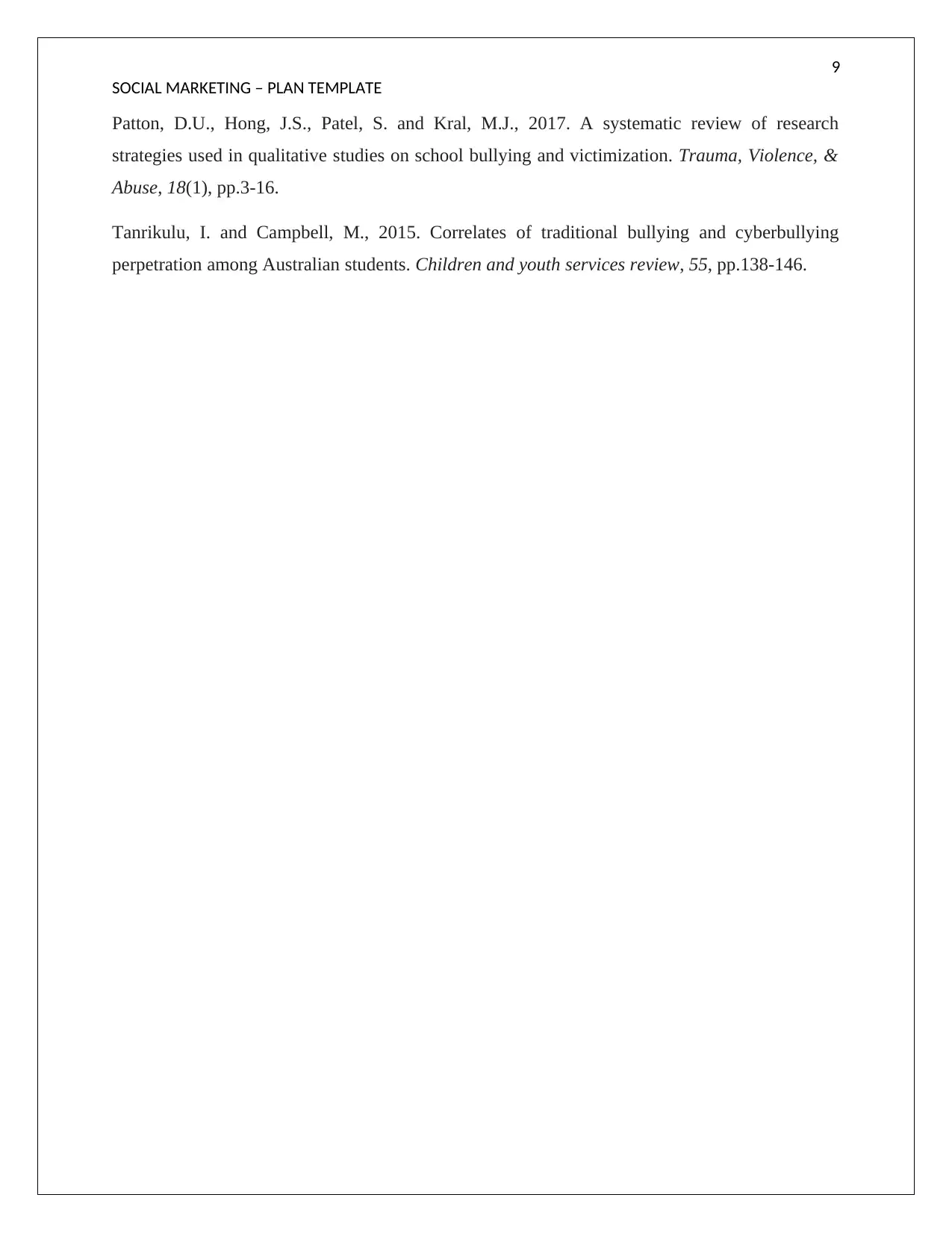
9
SOCIAL MARKETING – PLAN TEMPLATE
Patton, D.U., Hong, J.S., Patel, S. and Kral, M.J., 2017. A systematic review of research
strategies used in qualitative studies on school bullying and victimization. Trauma, Violence, &
Abuse, 18(1), pp.3-16.
Tanrikulu, I. and Campbell, M., 2015. Correlates of traditional bullying and cyberbullying
perpetration among Australian students. Children and youth services review, 55, pp.138-146.
SOCIAL MARKETING – PLAN TEMPLATE
Patton, D.U., Hong, J.S., Patel, S. and Kral, M.J., 2017. A systematic review of research
strategies used in qualitative studies on school bullying and victimization. Trauma, Violence, &
Abuse, 18(1), pp.3-16.
Tanrikulu, I. and Campbell, M., 2015. Correlates of traditional bullying and cyberbullying
perpetration among Australian students. Children and youth services review, 55, pp.138-146.
1 out of 10
Related Documents
Your All-in-One AI-Powered Toolkit for Academic Success.
+13062052269
info@desklib.com
Available 24*7 on WhatsApp / Email
![[object Object]](/_next/static/media/star-bottom.7253800d.svg)
Unlock your academic potential
Copyright © 2020–2025 A2Z Services. All Rights Reserved. Developed and managed by ZUCOL.





